
Visit Our Sponsors |
|
|
|
|
|
|
|
|
|
|
|
|
|
|
|
|
|
|
|
|
|
|
|
|
|
|
|
|
|
|
|
|
|
|
|
|
|
|
|
|
|
|
|
|
|
|
|
|
|
|
|
|
|
|
|
|

The research, which incorporates information from the United Nations’ World Risk Report, is based on data collected from 3,396 companies on behalf of 66 multinational purchasers that work with CDP (formerly called the Carbon Disclosure Project) to better understand and manage the environmental impacts of their supply chains; they account for $1.3tr in procurement spend and include organizations such as Nissan Motor Co. Ltd., and Unilever plc.
The sustainability risk matrix takes climate change mitigation strategies, carbon emissions reporting, target setting, emission reduction initiatives, climate risk procedures, uptake of low-carbon energy, water risk assessment efforts and collaboration into account. It reveals that:
• Suppliers in France, the UK, Spain and Germany – in that order – are identified as the most sustainable. They have taken extensive measures despite comparatively low levels of exposure to climate risk. However, the report notes a year-on-year decline in the percentage of German suppliers implementing a number of key environmental performance indicators, such as having a climate risk management processes in place, which has dropped from 82 percent to 72 percent.
• Japan is the only country with suppliers that are well-equipped to respond to high climate risks. They have some of the highest levels of emissions reporting, target setting and climate risk awareness.
• Suppliers in China, Italy and United States are found to be vulnerable. An imbalance between high exposure to climate risk and the steps that suppliers have taken in response leaves room for improvement in these geographies.
Even so, the United States has been identified by CDP as a polarized market, given that the majority constituent of the CDP Supplier Climate Performance Leadership Index – those suppliers identified as taking the most positive actions to address climate change – are headquartered in America.
• Brazil, Canada and India must do more as suppliers there who participated in the research report fewer emission reduction initiatives than the global average.
• A collaborative approach and profitable emissions reductions initiatives give China and India a competitive edge. Suppliers in China and India offer the best return on investment in terms of emissions reductions and monetary savings. Further, suppliers in both markets demonstrate the highest propensity to collaborate with partners across the value chain in order to reduce climate risk.
The global picture, which is presented alongside the country-by-country analysis, establishes some encouraging signs of global progress. More organizations than ever are assessing and reporting to CDP on their environmental impacts. The 3,396 companies that took part in the program this year represent a substantial increase of more than 40 percent in the past three years.
Further, the quantity and percentage of suppliers setting emissions targets, which is a crucial component of climate risk management, shows a steady upward trend: nearly half (48 percent) of suppliers set targets last year, compared to 44 percent in 2013 and 39 percent in 2012. There has also been an increase in the number of suppliers achieving emissions reductions since 2012, with the percentage rising from 34 percent to 40 percent in 2014. As suppliers become more advanced at carbon management, the number of companies realizing monetary savings from their actions to reduce emissions mirrors the rising trajectory, jumping from 29 percent in 2012 to 33 percent in 2014.
RELATED CONTENT
RELATED VIDEOS
Timely, incisive articles delivered directly to your inbox.







